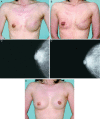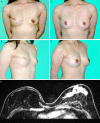Shaping of the Unaffected Breast with Brava-Assisted Autologous Fat Grafting to Obtain Symmetry after Breast Reconstruction
- PMID: 26026134
- PMCID: PMC4669992
- DOI: 10.1093/asj/sju156
Shaping of the Unaffected Breast with Brava-Assisted Autologous Fat Grafting to Obtain Symmetry after Breast Reconstruction
Abstract
Background: In breast reconstruction, symmetry is a vital issue. However, when the original breast is unusually shaped or the patient desires augmentation at the time of reconstruction, obtaining symmetrical breasts becomes difficult.
Objectives: The authors performed shaping of unaffected breasts by Brava-assisted autologous fat grafting to enhance breast symmetry, and evaluated the clinical results to validate this new approach.
Methods: Brava-assisted autologous fat grafting was performed to the unaffected breasts of 12 patients who had undergone unilateral breast reconstruction. The procedure was used for augmentation in six patients and to correct ptosis, volume, and tuberous breast deformity in three, two, and one patient, respectively. Clinical outcomes were assessed in all 12 patients.
Results: All patients could complete fat grafting within two sessions (one session in nine patients and two sessions in three patients). The mean volume of grafted fat per session was 211 cc in all patients. The mean retention rate of grafted fat was 58.9% in the 10 patients for whom the retention rate could be calculated using preoperative and postoperative magnetic resonance imaging (MRI). Postoperative MRI revealed small benign foci in two patients (16.7%), which were not palpable and did not become a clinical problem. A postoperative mammography revealed a small agglutinate calcification in one patient, which was determined to be benign through biopsy.
Conclusions: Shaping the unaffected breast by autologous fat grafting combined with Brava is predictable, effective, and feasible as an aesthetic adjunct to unilateral breast reconstruction to achieve breast symmetry.
Level of evidence: 4 Therapeutic.
© 2015 The American Society for Aesthetic Plastic Surgery, Inc. Reprints and permission: journals.permissions@oup.com.
Figures



References
-
- Stevenson TR, Goldstein JA. TRAM flap breast reconstruction and contralateral reduction or mastopexy. Plast Reconstr Surg. 1993;92:228-233. - PubMed
-
- LaTrenta GS, Hoffman LA. Breast reconstruction after mastectomy. In Rees TD, La Trenta GS, eds. Aesthetic Plast Surg . Philadelphia, PA: Saunders; 1994:996-1006.
-
- Hudson DA, Skoll PJ. Complete one-stage, immediate breast reconstruction with prosthetic material in patients with large or ptotic breasts. Plast Reconstr Surg. 2002;110:487-493. - PubMed
-
- Khouri RK, Schlenz I, Murphy BJ, Baker TJ. Nonsurgical breast enlargement using an external soft-tissue expansion system. Plast Reconstr Surg. 2000;105:2500-2512. - PubMed
-
- Schlenz I, Kaider A. The Brava external tissue expander: Is breast enlargement without surgery a reality? Plast Reconstr Surg. 2007;120:1680-1689. - PubMed
MeSH terms
LinkOut - more resources
Full Text Sources
Other Literature Sources
Medical
Research Materials

